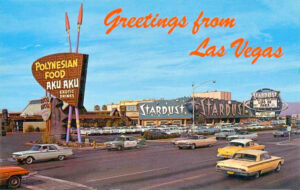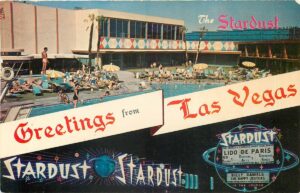 Opened on July 2, 1958, the Stardust Casino quickly emerged as a symbol of luxury, innovation, and glamour on the Las Vegas Strip. Designed by architect Max C. L. Wilson, the Stardust was more than just a casino; it was a trendsetter that redefined the standards of entertainment and hospitality in Las Vegas. Its striking neon sign, which became a defining landmark on the Strip, stood as a beacon, inviting high rollers, celebrities, and tourists alike to experience the cutting-edge allure of Las Vegas.
Opened on July 2, 1958, the Stardust Casino quickly emerged as a symbol of luxury, innovation, and glamour on the Las Vegas Strip. Designed by architect Max C. L. Wilson, the Stardust was more than just a casino; it was a trendsetter that redefined the standards of entertainment and hospitality in Las Vegas. Its striking neon sign, which became a defining landmark on the Strip, stood as a beacon, inviting high rollers, celebrities, and tourists alike to experience the cutting-edge allure of Las Vegas.
From the moment its doors opened, the Stardust made waves with its opulent design and high-profile entertainment. The casino featured state-of-the-art amenities, luxurious accommodations, and extravagant attractions that set it apart from its competitors. Its emphasis on innovation was evident in the early adoption of electronic slot machines, a groundbreaking move that revolutionized the gaming industry. The Stardust also hosted legendary performances by some of the biggest names in entertainment, further solidifying its reputation as a premier destination.

Themed attractions and grand events became synonymous with the Stardust experience. From its lavish show productions to its meticulously curated casino floor, the Stardust was always ahead of the curve, setting trends that others would soon follow. The casino's ability to blend sophistication with excitement attracted visitors from around the world, making it an integral part of the Las Vegas experience.
However, as the years passed, the Stardust faced increasing competition from newer, flashier resorts on the Strip. By the early 2000s, Las Vegas had transformed into a hub of mega-casinos and entertainment complexes, posing challenges for older properties like the Stardust. Despite this, it remained a beloved icon, cherished for its historical significance and the memories it created for countless visitors. Its closure in 2006 marked the end of an era, and the demolition of the Stardust in 2007 was a poignant moment for fans of classic Las Vegas.
While the physical structure of the Stardust is no longer standing, its legacy continues to shine through Stardust Social Casino. This online platform brings the spirit of the original Stardust to life, offering a virtual gaming experience that captures the excitement, glamour, and nostalgia of the historic casino. With a wide array of games, themed promotions, and an homage to the Stardust’s iconic branding, Stardust Social Casino ensures that the magic of the past remains accessible to new generations of players.
Stardust Social Casino not only celebrates the grandeur of its namesake but also provides a modern twist on its legacy. Through immersive virtual experiences, players can connect with the rich history of the Stardust while enjoying cutting-edge online gaming. By blending the past with the present, Stardust Social Casino keeps the memory of the Stardust alive, proving that its influence on Las Vegas and the gaming world remains timeless.
For those intrigued by the history of the Stardust, our exclusive article series delves deeper into its fascinating story. Explore the evolution of Boyd Gaming, the rise and fall of the Stardust Casino, and the tales of the visionaries who brought this iconic establishment to life. From its ties to organized crime to its cultural impact and architectural innovations, the Stardust's story is a captivating journey through the history of Las Vegas.
Discover More:
If you're interested in learning more about the legendary Stardust, we invite you to explore our exclusive article series about Boyd Gaming and the Stardust Casino:
The Evolution of Boyd Gaming: A Legacy of Entertainment and Innovation
Explore Boyd Gaming's journey from its humble beginnings to becoming a major player in the gaming industry, with the Stardust as a pivotal part of its legacy.
The Rise and Fall of Stardust Casino
Uncover the dramatic story of the Stardust’s meteoric rise, its challenges, and its ultimate closure, marking the end of a golden age in Las Vegas history.
Behind the Glitz: The Real Story of Stardust Casino and the Mob
Dive into the darker side of the Stardust's history, including its connections to organized crime and the infamous figures who influenced its operations.
Lights, Camera, Action: Stardust Casino in Popular Culture
Discover how the Stardust left its mark on movies, TV shows, and books, becoming an enduring symbol of Las Vegas in popular culture.
The Architects of Stardust: The Visionaries Who Built an Icon
Learn about the creative minds and bold entrepreneurs who envisioned and brought the Stardust to life, shaping its iconic status.
Stardust Casino's Impact on Las Vegas Tourism
Examine how the Stardust played a key role in transforming Las Vegas into the global entertainment capital it is today.
The Stardust may be gone, but its spirit lives on in the vibrant world of Stardust Social Casino and the enduring legacy it left behind.
